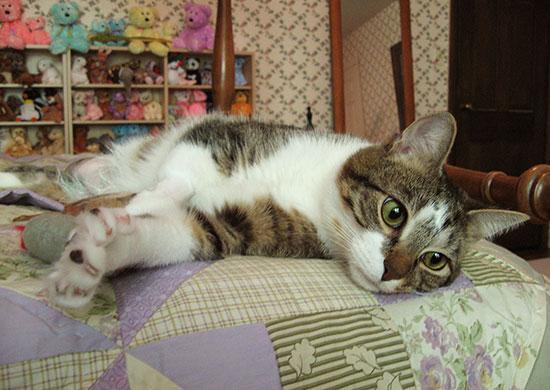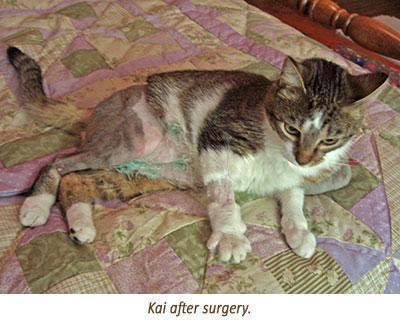This content is archived from the Feline Nutrition Foundation
Lessons From the Stoic Cat
- Updated: Sunday, May 26, 2019 04:19 PM
- Published: Sunday, November 29, 2009 12:56 PM
- Written by Margaret Gates
 Cats are often described as stoic – they don't let it show when they're sick. I think that's partly true. In the wild, they don't want to be obvious about being sick or injured. Showing that kind of weakness is a good way to get yourself eaten. It's better to hide until you feel well enough to pounce or run away.
Cats are often described as stoic – they don't let it show when they're sick. I think that's partly true. In the wild, they don't want to be obvious about being sick or injured. Showing that kind of weakness is a good way to get yourself eaten. It's better to hide until you feel well enough to pounce or run away.
When you share your life with a cat, you get to know them pretty well. Watching the subtle things, it's usually easy to tell when something is wrong – usually.
I'm always paying close attention to my cats. I check their behavior for anything that seems "off." When I was younger, I had a gray and white tuxedo cat. One day, I came home and found CJ curled up in a ball. Her bright pink nose was pale, almost white. Her breathing was shallow. She barely responded when I touched her. I panicked. I just knew she was at death's door – something was terribly wrong. I put her in a carrier and rushed her to the vet. On the way, she opened her eyes, but seemed disoriented. The vet saw her immediately. By then she was a bit perkier. She was looking around and color was returning to her nose. The vet checked her over and concluded I had found her deeply asleep. The color of her nose could vary depending on what she was doing. I was embarrassed. Imagine rushing your cat to the vet because she was sleepy! I always wondered if I became an anecdote for that vet. Am I The Terrified Lady with the Sleepy Cat?
I don't regret my reaction. I would rather overreact when it comes to my cats' health. Time can be of the essence. Some years back, I woke up to find Stanley, the Feline Nutrition logo cat, acting oddly. She didn't greet me in the usual way and her eyes weren't fully open. Her ears felt warm. She'd been acting completely normal the night before. I got her to vet right away, calling ahead as I was driving to say I had an emergency. By the time I got her there, she was listless and woozy. The vet determined Stanley had an infected salivary gland. She drained it, and got Stan on antibiotics and fluids. It was close. She had gone from normal to acting oddly in about seven hours, and from that to gravely ill in about two. If I'd had a wait-and-see attitude, she probably would have died.
 Then there are times when you can't tell anything is wrong. One day, when Kai was about a year and a half old, he jumped off a counter and gave a little cry. He was limping a bit, favoring his right rear leg. I checked his paw and leg and could find no obvious injury. He let me handle him, so he wasn't in too much pain. I made an appointment for him. The vet prodded and manipulated while looking thoughtful. She was pretty sure he had a broken hip! X-rays confirmed it. He had broken off the little round knob at the top of the femur – the one that rests in the hip bone socket in humans. I couldn't believe he'd done that jumping off the counter. Fortunately, I was able to get a 7:00 am appointment at a veterinary orthopedic surgeon for the next day.
Then there are times when you can't tell anything is wrong. One day, when Kai was about a year and a half old, he jumped off a counter and gave a little cry. He was limping a bit, favoring his right rear leg. I checked his paw and leg and could find no obvious injury. He let me handle him, so he wasn't in too much pain. I made an appointment for him. The vet prodded and manipulated while looking thoughtful. She was pretty sure he had a broken hip! X-rays confirmed it. He had broken off the little round knob at the top of the femur – the one that rests in the hip bone socket in humans. I couldn't believe he'd done that jumping off the counter. Fortunately, I was able to get a 7:00 am appointment at a veterinary orthopedic surgeon for the next day.
Next morning, the surgeon examined Kai, looked at the x-rays and confirmed a broken hip. It had been broken for at least three months! Talk about feeling like the worst kitty mom in the world. My cat had been walking around with a broken hip for three months, and I hadn't even noticed. Kai had only started to complain – or even act any differently at all – when the bone had started to re-grow and was rubbing. Jumping off the counter that single time set things off. We never could figure out how he'd broken it in the first place.
Additional Reading
If You're Feeling Stressed, So Is Your Cat
Let Me Tell You About Raw Cat Food. Hey Come Back!
Kai had his operation. The surgeon removed the knob entirely and smoothed the remainder. I had to give him physical therapy at home – which he hated – and after about eight months he was good as new. The muscles hold everything in place, so he does fine without that little knob.
The lessons learned are to pay close attention to your cats, err on the side of a wasted vet visit and hope what your cats do manage to hide from you isn't immediately life-threatening.
Margaret Gates is the founder of the Feline Nutrition Foundation.




